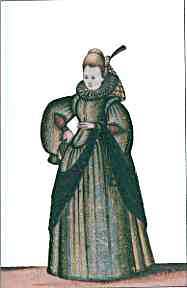Stage costumes
A company's costumes were among its most valued assets*; individual costumes often cost more than the outright purchase of a play.
Philip Henslowe once purchased a "black velvet cloak with sleeves embroidered all with silver and gold," for £20 10s 6d, more than a third of the price Shakespeare paid for New Place, the finest house in Stratford.
Actors were known to wear their stage finery in the streets, and were criticized for emulating their betters. In 1579, Gosson complained:
The very hyrelings. . . under gentlemen's noses in sutes of silke. . . look askance over the shoulder at every man, of whom the Sunday before they begged an almes.
Even Philip Henslowe disapproved of actors wearing their costumes off stage* -- though this was probably more to ensure that his investment in the costume was not threatened.
A discussion of the recreation of Elizabethan costumes on the stage of the New Globe.
Footnotes
-
Valuable assets
Some costumes actually came from the wardrobes of the nobility; Thomas Platter noted in 1599 that "it is the English usage for eminent lords or knights at their decease to bequeath and leave almost the best of their clothes to their serving men, which it is unseemly for the latter to wear, so that they offer them then for sale for a small sum to the actors."
-
A fine for wearing a costume
A contract between Robert Dawes and Phillip Henslowe specified that should the actor "at any time after the play is ended depart or goe out. . . with any apparell [costume] on his body," he would be charged the considerable sum of forty pounds.
